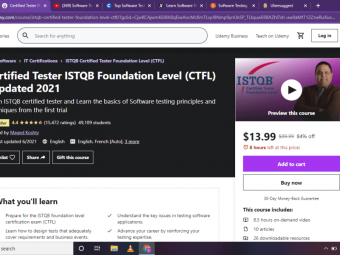Sql From Scratch Using Oracle Sql Developer And Toad
Tags: Oracle SQL
Learn how to query databases using SQL
Last updated 2022-01-10 | 4.7
- Choose the right logical operators for your queries- Choose the right logical SET operators for your queries
- Write SQL Queries to extract data
What you'll learn
* Requirements
* Download Oracle Database and Tools. We will cover this in the courseDescription
Learning SQL is a very useful skill to have as every business and organisation is so dependent on data. There are not enough skilled SQL professionals hence the demand and pay rate for SQL professionals is quite high.
SQL stands for structured query language. It is an international standard language
used to query and manipulate databases. There are different types of database
vendors like Oracle, Microsoft ,MySQL and so on . They all support SQL and
performs certain operations in the same way. Keywords like CREATE,SELECT,UPDATE,
DELETE,WHERE and FROM are used the same way with various database vendors.
This course will teach you the skills you need to get your foot in the door
as an SQL professional. With the skills you learn on this course you can work
confidently as a data analyst or even progress to be a database administrator.
This course will take from scratch to more advanced SQL using TOAD and SQL Developer TOOL
Some of what you will learn on this course includes:
- Database concepts
- SQL SUB Languages -DDL and DML
- Aggregate Functions
- Logical Operators
- SET Operators
- Table Joins
- Analytic Functions
- Single Row Functions
- Creating Tables
- Creating Views
- Creating Sequences
- Creating Indexes
- Using Aliases
- Using Sub Queries
- NULL Values
- Restricting and Limiting Data
By the end of this course you will confidently be able to write SQL queries
to create,read,update and delete data which are the key functions that are performed
on a database.
Who this course is for:
- Anyone who wants to learn SQL
- Anyone who is interested in databases
- This course is meant for those not familiar with SQL syntax
- Beginner DBA
Course content
12 sections • 112 lectures
Introduction Preview 06:05
What is SQL ? Preview 01:57
Professional Tools Preview 08:39
Download and install Oracle Database Preview 08:11
Unlock Sample Database Schema and Objects Preview 05:04
Download and Install TOAD Preview 07:09
Connect TOAD to Oracle database Preview 06:38
Exploring TOAD Preview 05:41
Download and install Oracle SQL Developer Preview 08:55
Connect SQL Developer to Oracle database Preview 06:05
Oracle 18c Installation Preview 07:59
SQLplus Preview 03:23
Unlock Schema for Oracle 18c Preview 05:29
Install Oracle Developer Preview 05:49
Connect to Oracle with SQL Developer Preview 04:27
Database Concepts Preview 07:09
Database Views and Dual Tables Preview 06:06
Using Describe Preview 03:18
Using Synonyms Preview 06:05
Creating and using Indexes Preview 06:17
What is an ERD Preview 05:32
Generating ERD with TOAD Preview 03:59
Generating ERD with SQL Developer Preview 13:02
Introduction to SQL Sub-languages Preview 03:05
Data Definition Language :DDL CREATE Preview 08:50
Data Definition Language :DDL CREATE Continued Preview 08:03
Data Definition Language :DDL DROP,TRUNCATE and ALTER Preview 08:38
Data Manipulation Language: DML SELECT Preview 09:15
Data Manipulation Language: DML INSERT Preview 09:32
Data Manipulation Language: DML UPDATE and DELETE Preview 07:02
What are Single Row Functions Preview 00:59
Character Functions Preview 07:50
Conversions Functions Preview 06:48
Date Functions Preview 05:02
Numeric Functions Preview 05:25
Data Types and Constraints Preview 09:37
NULL Values Preview 07:51
What are Sequences Preview 06:34
How to create Sequences Preview 04:57
How to use Sequences Preview 07:48
Using Aliases Preview 07:47
Restricting and Sorting Data Preview 07:18
Using Sub -Queries Preview 08:38
Removing Duplicate records Preview 05:52
Using SQL FROM Clause Preview 02:51
Using SQL WHERE Clause Preview 05:22
Using SQL ORDER BY Clause Preview 05:48
Using SQL GROUP BY & HAVING Clause Preview 07:35
SQL LIKE Operator Preview 09:18
Why the need to join tables Preview 04:11
Table Join Keywords Preview 08:40
Equi Join Preview 07:46
Non Equi Join Preview 07:26
Cartesian Join Preview 06:19
Outer Join Preview 08:14
Self Join Preview 09:53
Natural Joins Preview 07:04
What are Aggregate Functions Preview 01:38
AVG () Aggregate Functions Preview 03:20
COUNT () Aggregate Function Preview 04:40
MAX () Aggregate Function Preview 03:13
MIN () Aggregate Function Preview 02:48
What are SET Operators Preview 04:35
Union All SET Operator Preview 05:23
INTERSECT SET Operator Preview 02:50
MINUS SET Operator Preview 01:48
SET Operators Summary Preview 03:31
What are Analytic Functions Preview 06:43
How to write Analytic Functions Preview 04:07
The PARTITION BY Clause Preview 08:04
ORDER BY Clause Preview 05:48
Windowing Clause Preview 02:10
Row number Functions Preview 09:26
Rank Function Preview 06:04
Dense Rank Function Preview 05:57
Lag Function Preview 03:37
ListAgg Function Preview 06:14
Lead Function Preview 06:43
First and Last Functions Preview 08:56
What is a Flashback Query Preview 05:18
Undo Parameters Preview 05:11
Session level flashback Preview 08:59
Rolling Back Data Preview 05:35
Rolling Back Data Continued Preview 10:57
Session Flashback Preview 06:57
Introduction Preview 00:40
ANY Operator Preview 04:01
ALL Operator Preview 04:01
SQL IN Operator Preview 04:48
SQL IS NULL Operator Preview 02:42
AND operator Preview 04:46
NOT Operator Preview 02:49
OR Operator Preview 04:12
SQL Query To Determine Employees Count Preview 03:27
SQL Query to Update employee salary Preview 11:07
Use SQL to generate Salary reports Preview 06:24
Generating a report of employees with no managers Preview 04:49
Insert new records into a database Preview 09:12
Create a new database Table Preview 07:42
Delete Records from a Table Preview 05:11
Use SQL to determine number of employees Preview 03:27
Generate a report showing when employees where hired. Preview 12:44
How to Check Current Schema Preview 02:00
How to check Current Database version Preview 01:45
How to check if Table Contains Any Data Preview 01:27
How to convert Numbers into Words Preview 02:54
How to check the size of a Database Preview 01:54
How to check days left in a Month Preview 03:41
How to generate Random Numbers Preview 02:03
How to check how many days in a month Preview 02:11
SQL QUIZ
This quiz will test your knowledge on what you have learnt








 This course includes:
This course includes:
















